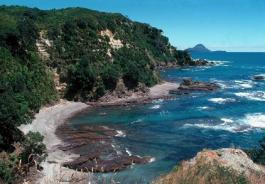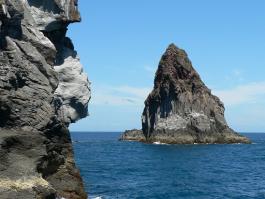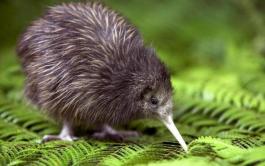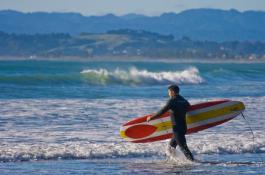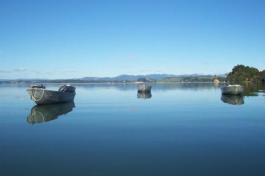View local Ohope Beach Attractions with Google Street View here!
Click here to view Ohope Beach Activity & Attraction Operators.
Click here for....
Bird Watching at Ohope, Otarawairere Bay and Ohiwa Harbour.
Ohope Beach
A walk along Ohope Beach will invigorate you, whatever the weather. Many seabirds use the beach as a resting-place. In particular the red-billed and black-backed gulls. These may be seen bathing in the streams that enter the sea at various points along the beach. You may also see a black-backed gull dropping shellfish from a height to break it open. Another bird to be seen in the white-fronted tern, unlike the caspian tern this bird does not have the heavy orange bill and is smaller. The white-fronted tern is a swift flier and is one bird that is targeted by the skua. The skua chases the tern making it disgorge its last meal of fish, saving the skua having to find the fish itself. The variable oystercatcher is also seen probing the sand for marine worms etc. During the breeding season the beaks and legs of these birds turn a very rich orange.
If you are really lucky you may have the chance to see seabirds feeding in a big work-up of fish. Gannets dive from a great height and go under the fish and catch it on the way up after the dive. Many types of petrels, terns and gulls may also be drawn to the work-up. Did you know that gannets along with a few other birds like shags and pelicans do not have external nostrils and breath from the side of the mouth. (White Island, which you can see on the horizon, is where the gannets have their nests).
Walking through the reserve to get to the beach along Ocean Road are many introduced birds, different sorts of finches, (green, gold, and chaffinch), yellow hammer, starling, myna and sparrow, as well as the magpie. You may disturb a pheasant or Californian quail; there may also be some brown quail. The New Zealand bush falcon also quarters this area trying to flush out birds. The falcon will take live birds whereas the Australasian Harrier Hawk will take road kills and carrion.
Birds like the New Zealand dotterel, banded dotterel and the variable oystercatcher lay they eggs above the high tide mark in a nest scraped in the sand. They are very hard to see, the eggs being the same colour as the sand, and many get trampled on, for this reason it is recommended that people walk on or below the high tide mark when nearing the Ohope Spit. Predators of the eggs of these birds are hedgehogs, rats, stoats, black-backed gulls etc. Four wheel drive vehicles, motor bikes and horses going above the high tide mark can destroy nests, as they would not see them. Some birds will pretend they are injured to draw you away from their nest site or young chicks. Once the chicks have hatched they can become prey to black-backed gulls, stoats cats, dogs or birds of prey. The endangered New Zealand Dotterel only number around 1400 birds.
Hawks are again seen over the Ohope Spit looking for prey, they may also have nests in this area. Hawks nest on the ground not in trees. As well as quail, pheasants and the introduced birds the Ohope Spit is home to some fernbirds. These birds are brown in colour and are a little larger than a sparrow but have a dropping tail and are very poor fliers. Yellow hammers, skylarks and pipits may also be seen and heard.
Along the walk around the harbour back to the Ohiwa Wharf you may see some of the four types of shags that frequent the harbour. The smallest is the little black shag, followed by the little (or little pied) shag, the black shag and pied shag. Very occasionally we may have a visit from the spotted shag.
Herons to be seen are the white-faced and reef heron. Some of the migratory birds may also be seen on the Ohope side of Ohiwa Harbour.
After a bad storm often seabirds are washed up on the beaches around New Zealand. Sometimes a bird is found alive and this is then brought into Whakatane Bird Rescue.
Ohiwa Harbour
Ohiwa Harbour is home to many birds, not only have you the resident birds but also migratory ones use the harbour as their feeding grounds during the northern hemisphere's winter. It will also pay to have a really good book on migrant birds as many unusual species are sometimes to be found in the flocks of bar-tailed godwits feeding on sandbanks or roosting at high tide around Tern Island and the Ohiwa Spit.
Some birds are so secretive that it is very hard to spot them, but if you spend time just sitting and watching the edges of the harbour you may be rewarded by seeing some of the following birds. The bittern may be found in the tall reeds. It will freeze with its beak pointing skywards. The Banded Rail is found around the harbour and may be seen on the edge of the saltmarsh or mangroves. Also the spotless crake which is a tiny bird slightly smaller than a blackbird. Pukeko inhabit some of the harbour edges, and the fernbirds may be found in areas of shrubbery around the harbour. Some of the migratory birds may also use this area to fossick for food in the harbour margins. At low tide many birds can be seen on the sandbars and mud flats, ranging from pied stilts, the variable and South Island pied oystercatcher. (The difference between the two is the South Island or pied, as it is sometimes known, has white going up from the chest to high on the shoulders whereas the variable is either all black or black and white without the white shoulders).
The South Island pied oystercatcher spends the winter here and non-breeders may stay the whole year. White-faced herons, kingfishers, and another visitor that are sometimes seen is the Royal spoonbill. A few years ago five or six were seen resting on Tern Island. Tern Island is a wildlife refuge (Dogs are not allowed in wildlife refuges) and has the New Zealand dotterel, white-fronted tern, variable oystercatcher, white-faced heron, fernbird, caspian tern, and red-billed and black-backed gull breeding. The following birds have been seen on Tern Island: - Reef heron, bar-tailed godwit, Asiatic whimbrel, eastern curlew, little tern, spur-winged plover, pied stilt, black, pied, little black and little pied shags have all been seen at different times and I believe one spotted shag was sighted.
On the sand spit on the Opotiki side of Ohiwa Harbour the bar-tailed godwits roost at high tide, while some of these birds overstay during the northern summer many return each year from the Artic Tundra where they have spent the Northern Hemisphere breeding. From September to April some of these birds return to New Zealand and may be viewed feeding or resting. In amongst them other migrant birds may be found like the sandpipers, plovers, stints, turnstone etc. You do need time to just sit and watch from a distance.
The danger with walking on the spit is at nesting time - spring through to the end of Summer - birds lay their eggs in the sand in a small hollow, the eggs are the colour of sand and cannot be seen. Four-wheeled drive vehicles, dogs, and humans have a detrimental effect on these birds. The New Zealand dotterel number around 1400 birds and many nests get disturbed and abandoned. The other birds nesting here are the variable oystercatcher and white-fronted tern (some years the terns move over to Tern Island to nest). Not only do the birds have to put up with human traffic but also because of the low lie of the spit, in really rough weather, wind and the sea destroys the nests.
Many other birds may be seen on the harbour that are not listed, I have seen black swan and many types of ducks, geese etc. Ohiwa Harbour Tours operate an excellent experience on the harbour aboard a safe and comfortable pontoon type boat.
Otarawairere Bay
Please note that dogs are not allowed on the whole of the walkway including Otarawairere Beach.
Walk to Otarawairere Beach from West End Ohope, you can find this walkway at the western end of Ohope. It is part of the Nga Tapuwae O Toi walkway (footprints of Toi) joining up the Mokorua and Ohope Scenic Reserves.
Fantails fly around your head getting the insects that you disturb during your walk. Tui and bellbird feed on the pohutukawa flowers and flax. Grey warblers and waxeyes can also be heard and seen, the shining cuckoo, which arrives in September maybe heard in the bush. This bird lays its egg in the warbler's nest and leaves the warbler to hatch and feed its young. The heavy flap of wings may announce the New Zealand Native Pigeon is nearby.
The New Zealand Falcon has been observed from the walkway resting on a branch of an overhanging tree. Kaka visit in winter. Birds that nest in burrows along the track are the grey-faced petrel and little blue penguin. Kiwi use to be heard in the bush at night and may still be present in the bush. On arriving in the bay you may see the variable oystercatcher with its long orange beak looking for food on the rocks [variable oystercatcher] nearby, or a kingfisher watching for a tasty meal. Other seabirds to visit this bay are the white-fronted tern, red-billed gull, and black-backed gull. Nests of pied shags can be seen in pohutukawa overhanging the rocky outcrop between the two main beaches at Otarawairere. Gannets may be seen diving just off the bay for fish. Another bird that may be seen gazing in the large pools looking for fish is the reef heron.
A walk at night coming in from Otarawairere Village track will let you see glow worms. These can be found further half way down the track towards the bay. Also listen for the sound of the morepork calling, or the screech of the long-tailed cuckoo which arrives back in New Zealand around October. This bird lays its egg in the whitehead's nest.
If you feel really energetic, you can continue your walk to Kohi Point by taking the steps at the western end of Otarawairere Bay. This will take you through more bush, past grey-faced petrel and penguin burrows. There are a few seats to rest and gaze out to White and Whale Island. You will go past many pa sites, ending at the top of Kohi Point Road with a view over Whakatane. If you walk down the metal road turn right on to Otarawairere Road and continue you will be back at the Ohope/Whakatane turnoff.
Maori had gardens planted and grew their vegetables and fruit near the pa sites, and tracks led from Whakatane to Otarawairere Bay for the gathering of shellfish and catching fish.
Some important dates for Otarawairere Bay.
1769 saw Captain Cook sail past the bay but he did not stop.
In 1954 Otarawairere Bay was the setting for a film called "The Seekers", this starred Jack Hawkins and Glynis Johns and a track was put in from the Ohope Road. Many local people helped as extras in the film.
1959/60 The Tasman Pulp and Paper Mill started building houses in Otarawairere Village for its employees
Contributed by Rosemary Tully of Whakatane Bird Rescue.

